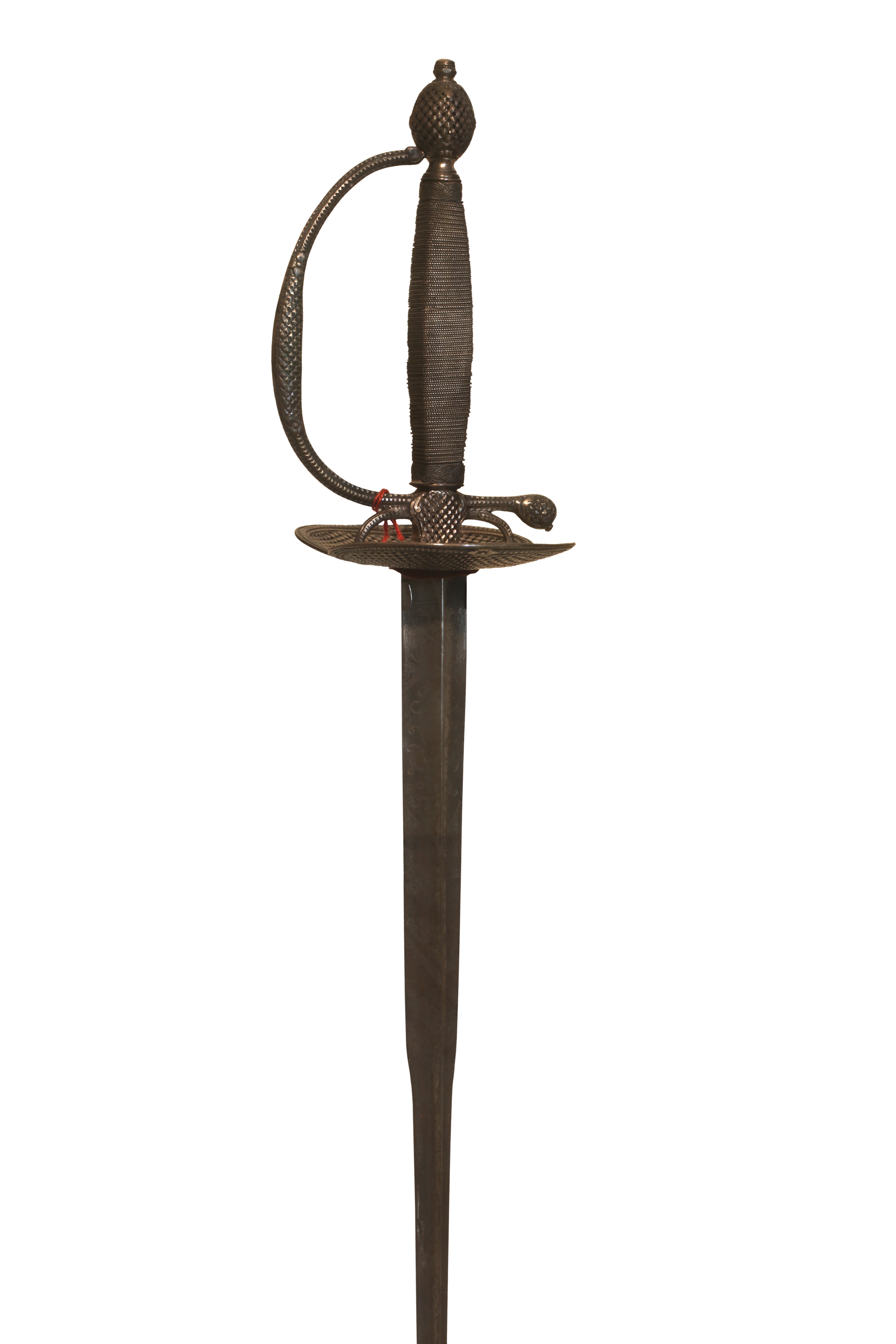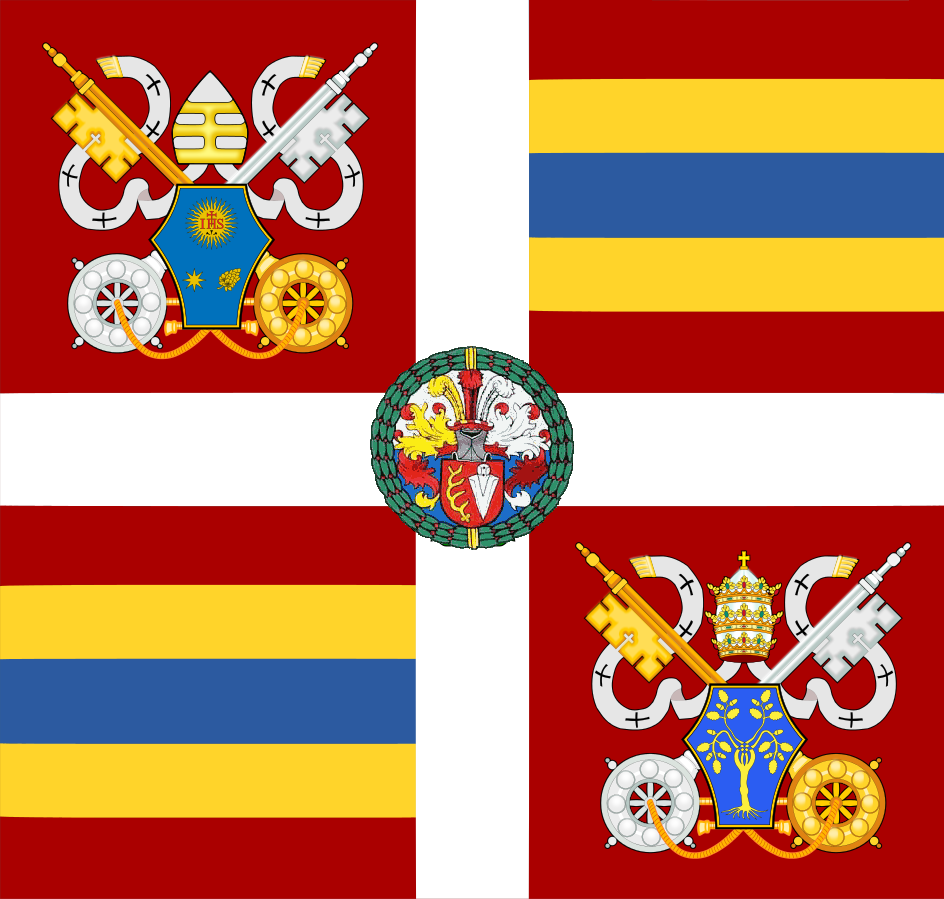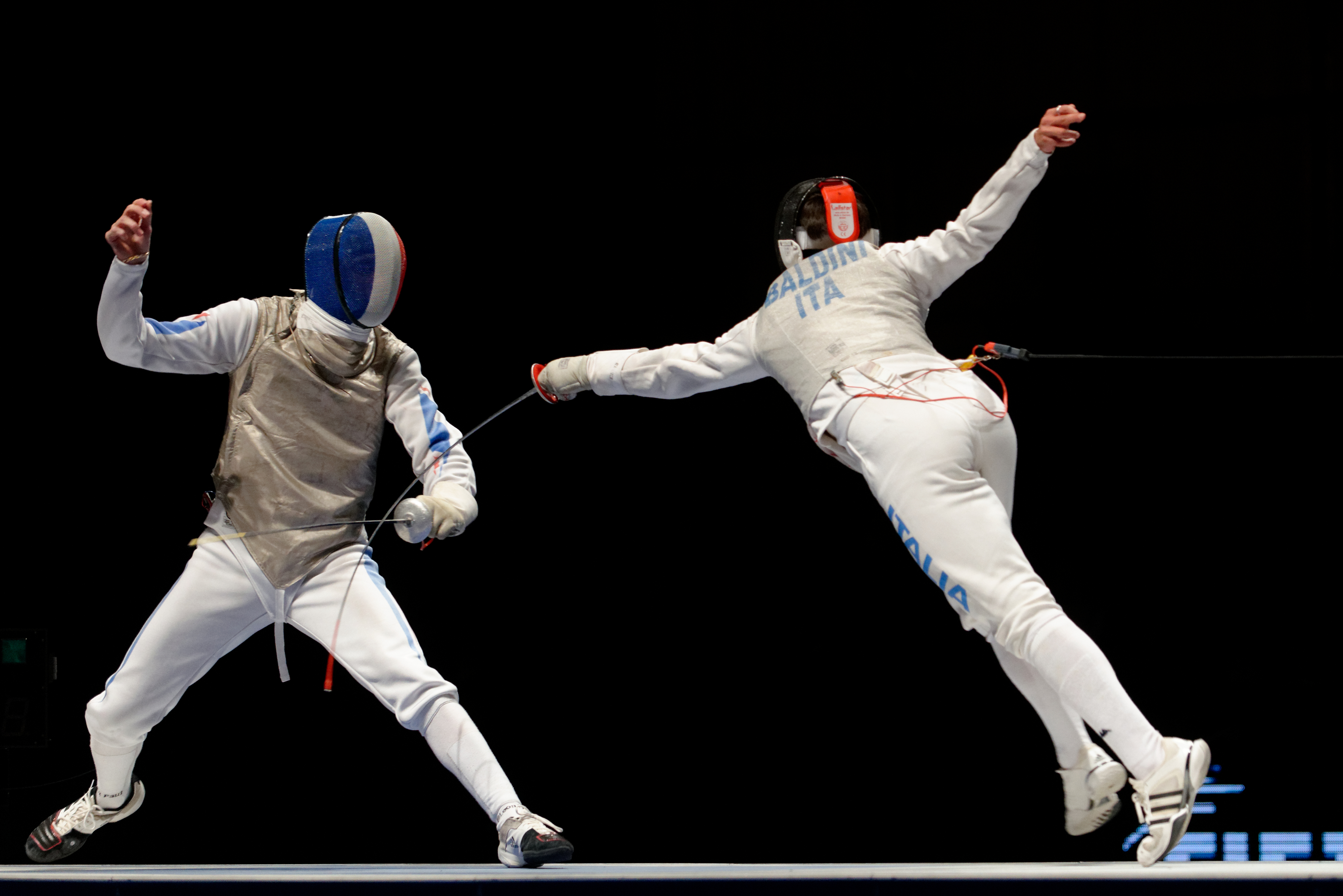|
Flame-bladed Sword
A flame-bladed sword or wave-bladed sword has a characteristically undulating style of blade. The wave in the blade is often considered to contribute a flame-like quality to the appearance of a sword. The dents on the blade can appear parallel or in a zig-zag manner. The two most common flame-bladed swords are rapiers or ''Zweihänders''. A flame-bladed sword was not exclusive to a certain country or region. The style of blade can be found on swords from modern-day Germany, France, Spain, and Switzerland. ''Flambard'', ''Flammard'', and ''Flammenschwert'' The two-handed flame-bladed sword is referred to by the German ''Flammenschwert'' (literally "flame sword"). These swords are very similar to two-handed sword or ''Zweihänder'', the only difference being the blade. The design of the blade is decorative along with being functional by causing unpleasant vibrations while parrying. Still, the undulating blade is no more effective at cutting than a straight one. An advantage over ... [...More Info...] [...Related Items...] OR: [Wikipedia] [Google] [Baidu] |
German - Two-handed Sword - Walters 511335
German(s) may refer to: * Germany (of or related to) **Germania (historical use) * Germans, citizens of Germany, people of German ancestry, or native speakers of the German language ** For citizens of Germany, see also German nationality law **Germanic peoples (Roman times) * German language **any of the Germanic languages * German cuisine, traditional foods of Germany People * German (given name) * German (surname) * Germán, a Spanish name Places * German (parish), Isle of Man * German, Albania, or Gërmej * German, Bulgaria * German, Iran * German, North Macedonia * German, New York, U.S. * Agios Germanos, Greece Other uses * German (mythology), a South Slavic mythological being * Germans (band), a Canadian rock band * German (song), "German" (song), a 2019 song by No Money Enterprise * ''The German'', a 2008 short film * "The Germans", an episode of ''Fawlty Towers'' * ''The German'', a nickname for Congolese rebel André Kisase Ngandu See also * Germanic (disambi ... [...More Info...] [...Related Items...] OR: [Wikipedia] [Google] [Baidu] |
Chivalric Romance
As a literary genre, the chivalric romance is a type of prose and verse narrative that was popular in the noble courts of High Medieval and Early Modern Europe. They were fantastic stories about marvel-filled adventures, often of a chivalric knight-errant portrayed as having heroic qualities, who goes on a quest. It developed further from the epics as time went on; in particular, "the emphasis on love and courtly manners distinguishes it from the ''chanson de geste'' and other kinds of epic, in which masculine military heroism predominates." Popular literature also drew on themes of romance, but with ironic, satiric, or burlesque intent. Romances reworked legends, fairy tales, and history to suit the readers' and hearers' tastes, but by c. 1600 they were out of fashion, and Miguel de Cervantes famously burlesqued them in his novel ''Don Quixote''. Still, the modern image of "medieval" is more influenced by the romance than by any other medieval genre, and the word ''medieva ... [...More Info...] [...Related Items...] OR: [Wikipedia] [Google] [Baidu] |
Flaming Sword (mythology)
A flaming sword is a sword which is glowing with a flame which is produced by some supernatural power. Flaming swords have existed in legends and myths for thousands of years. In Sumerian mythology, the deity known as Asaruludu is "the wielder of the flaming sword" who "ensures the most perfect safety". Abrahamic sources According to the Bible, a flaming sword ( he, להט החרב ''lahat chereb'' or literally "flame of the whirling sword" he, להט החרב המתהפכת ''lahaṭ haḥereb hammithappeket'') was entrusted to the cherubim by God to guard the gates of Paradise after Adam and Eve were banished (Genesis 3:24). Scholars have variously interpreted the sword as a weapon of the cherubim, as lightning, as a metaphor, as an independent angel, divine being, or even as a figurative description of bladed chariot wheels. In Kabbalah, the flaming sword represents the order which the sefirot were created in, also known as “''the path of the flaming sword.”'' Easter ... [...More Info...] [...Related Items...] OR: [Wikipedia] [Google] [Baidu] |
Colichemarde
Colichemarde is a type of small sword (often written "smallsword") blade that was popular from the late 17th century to the middle 18th century. Overview The small sword is considered to be a descendant of the "transitional rapier", which itself evolved from the rapier due to the demand for a lighter sword, easier to wear. The shape of a colichemarde blade features a wide forte, which abruptly tapers to a much narrower form at a point varying between a fifth to a third of the blade length from the hilt. The blade cross section was most often triangular and hollow-ground. This configuration combines good parrying characteristics, due to the wide blade forte, with the good maneuverability and thrusting characteristics imparted by the narrow blade foible. Its lighter weight, shorter length and superior balance, compared to the rapier, allowed faster and more accurate movement of the blade. This enabled the fencer to achieve a more precisely targeted thrust on an adversary. The poi ... [...More Info...] [...Related Items...] OR: [Wikipedia] [Google] [Baidu] |
Swiss Guard
The Pontifical Swiss Guard (also Papal Swiss Guard or simply Swiss Guard; la, Pontificia Cohors Helvetica; it, Guardia Svizzera Pontificia; german: Päpstliche Schweizergarde; french: Garde suisse pontificale; rm, Guardia svizra papala) is an armed force and honour guard unit maintained by the Holy See that protects the Pope and the Apostolic Palace within the territory of the Vatican City. Established in 1506 under Pope Julius II, the Pontifical Swiss Guard is among the oldest military units in continuous operation. The dress uniform is of blue, red, orange and yellow with a distinctly Renaissance appearance. The Swiss Guard are equipped with traditional weapons, such as the halberd, as well as with modern firearms. Since the assassination attempt on Pope John Paul II in 1981, a much stronger emphasis has been placed on the Guard's non-ceremonial roles, and has seen enhanced training in unarmed combat and small arms. Recruits to the guards must be unmarried Swiss Cathol ... [...More Info...] [...Related Items...] OR: [Wikipedia] [Google] [Baidu] |
Parrying Hooks
A parry is a fencing bladework maneuver intended to deflect or block an incoming attack. Execution To execute a parry, fencers strike the opponent's foible, or the area near the tip of the blade, with their forte, or the part of the blade near the bell guard (or handle) of the weapon. This deflects the opponent's blade away from them, protecting them and placing them in a good position to strike back. Approximations of the precise parries are made often during bouts, but are usually accurate enough to be classed as parries. In épée, because of absence of priority rules (see right-of-way), a parry can be classed as any deflection of the blade that prevents the opponent's attack from landing. Use The primary function of a parry is to prevent an opponent's attack from landing. During a bout, parries are commenced from the "en garde" (neutral) position, when an opponent's attack is considered threatening. A parry is usually followed by a ''riposte'', which is an attack back agai ... [...More Info...] [...Related Items...] OR: [Wikipedia] [Google] [Baidu] |
Ricasso
A ricasso is an unsharpened length of blade just above the guard or handle on a knife, dagger, sword, or bayonet. Blades designed this way appear at many periods in history in many parts of the world and date back to at least the Bronze Age—essentially, as long as humans have shaped cutting tools from metals. There were many reasons to make a blade with a ricasso, and in Europe, later longswords, claymores, rapiers and other lengthy swords often had this feature. One very simple influence presently and historically is fashion, which often answers this question for blades where the presence or lack of a ricasso has no effect on how it is used.{{dubious, date=March 2012 Leaving a ricasso can also save the blade maker's time—a section of blade that would not be used given the purpose of the piece does not have to be shaped and sharpened. In many cases however, they are quite functional. Historically, ricassos were commonly present on medieval and early Renaissance swords. The b ... [...More Info...] [...Related Items...] OR: [Wikipedia] [Google] [Baidu] |
Chanson De Geste
The ''chanson de geste'' (, from Latin 'deeds, actions accomplished') is a medieval narrative, a type of epic poem that appears at the dawn of French literature. The earliest known poems of this genre date from the late 11th and early 12th centuries, shortly before the emergence of the lyric poetry of the troubadours and trouvères, and the earliest verse romances. They reached their highest point of acceptance in the period 1150–1250.Hasenohr, 242. Composed in verse, these narrative poems of moderate length (averaging 4000 lines) were originally sung, or (later) recited, by minstrels or jongleurs. More than one hundred ''chansons de geste'' have survived in approximately three hundred manuscripts''La Chanson de Roland,'' 12. that date from the 12th to the 15th century. Origins Since the 19th century, much critical debate has centered on the origins of the ''chansons de geste'', and particularly on explaining the length of time between the composition of the ''chansons'' a ... [...More Info...] [...Related Items...] OR: [Wikipedia] [Google] [Baidu] |
Blade
A blade is the portion of a tool, weapon, or machine with an edge that is designed to puncture, chop, slice or scrape surfaces or materials. Blades are typically made from materials that are harder than those they are to be used on. Historically, humans have made blades from flaking stones such as flint or obsidian, and from various metal such as copper, bronze and iron. Modern blades are often made of steel or ceramic. Blades are one of humanity's oldest tools, and continue to be used for combat, food preparation, and other purposes. Blades work by concentrating force on the cutting edge. Certain blades, such as those used on bread knives or saws, are serrated, further concentrating force on the point of each tooth. Uses During food preparation, knives are mainly used for slicing, chopping, and piercing. In combat, a blade may be used to slash or puncture, and may also be thrown or otherwise propelled. The function is to sever a nerve, muscle or tendon fibers, or bloo ... [...More Info...] [...Related Items...] OR: [Wikipedia] [Google] [Baidu] |
Durendal
Durendal, also spelled Durandal, is the sword of Roland, a legendary paladin and partially historical officer of Charlemagne in French epic literature. It is also said to have belonged to young Charlemagne at one point, and, passing through Saracen hands, came to be owned by Roland. The sword has been given various provenances. Several of the works of the Matter of France agree that it was forged by Wayland the Smith, who is commonly cited as a maker of weapons in chivalric romances. Etymology The name Durendal arguably begins with a French ''dur-'' stem, meaning "hard". Thus Rita Lejeune argued it may break down into ''durant'' + ''dail'', renderable in English as "strong scythe" or explained in more detailed to mean "a scimitar or scythe which holds, up, resists, endures". Gerhard Rohlfs suggested ''dur'' + ''end'art'' or "strong flame". The name may also connote the meaning of "enduring". The '' Pseudo-Turpin'' explains that the name "Durenda is interpreted to mean it give ... [...More Info...] [...Related Items...] OR: [Wikipedia] [Google] [Baidu] |
Egerton Castle
__NOTOC__ Egerton Castle M.A., F.S.A. (12 March 1858 – 16 September 1920) was an author, antiquarian, and swordsman, and an early practitioner of reconstructed historical fencing, frequently in collaboration with his colleague Captain Alfred Hutton. Castle was the captain of the British épée and sabre teams at the 1908 Summer Olympics. He was born in London into a wealthy family; his maternal grandfather was the publishing magnate and philanthropist Egerton Smith. He was a lieutenant of the Second West India Regiment and afterwards a captain of the Royal Engineers Militia. He was also an expert on bookplates and a keen collector. Egerton Castle co-authored several novels with his wife, Agnes (née Sweetman). Selected works *''Schools and Masters of Fencing : From the Middle Ages to the Eighteenth Century'', (2005), (2006). (The first edition: G. Bell & Sons, London 1885)"The Baron's Quarry"(short story) *Consequences. London: Richard Bentley and Son. 1891. 3 volume ... [...More Info...] [...Related Items...] OR: [Wikipedia] [Google] [Baidu] |





